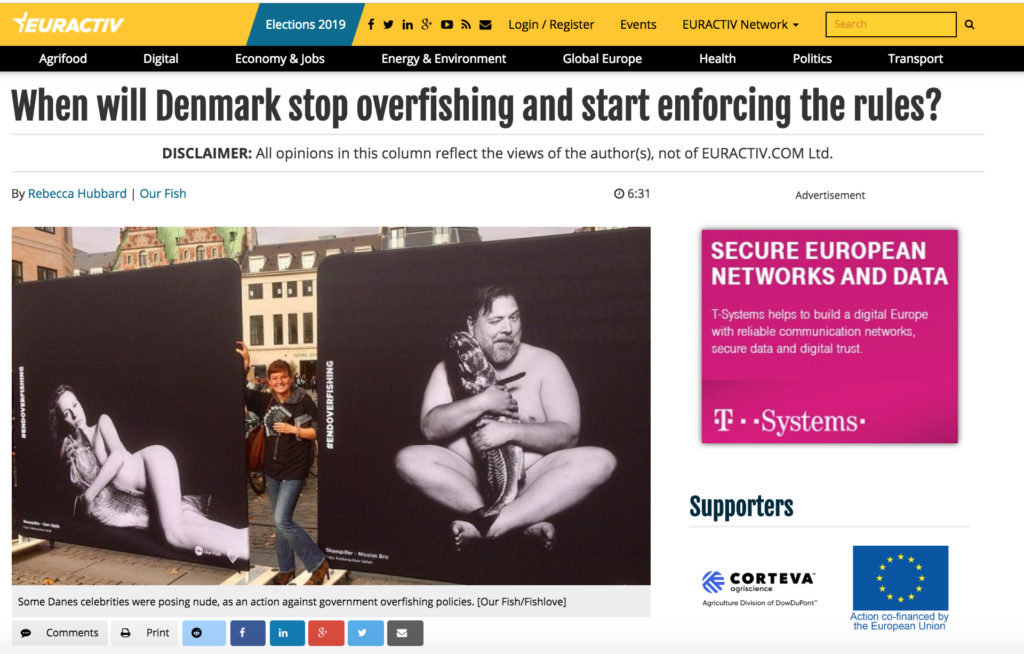
First published on Euractiv, 12 October 2018.
Denmark has become the worst perpetrator of Baltic overfishing over the last years, putting in serious danger entire species, such as the Baltic’s iconic cod, warns Rebecca Hubbard.
Rebecca Hubbard is the program director of Our Fish, an NGO that works to end overfishing and wasteful discarding, and challenges EU governments to deliver transparent, sustainable management of Europe’s fisheries.
Last week, six of Denmark’s best-known actors appeared in national media, stark naked, along with a fine specimen of Baltic cod.
This bold act by Thure Lindhardt, Trine Dyrholm, Iben Hjejle, Lars Brygmann, Natalie Madueno and Nicolas Bro was powered by their desire to see Denmark’s government reverse the damage done by years of overfishing and by both following and enforcing the laws designed to sustain our fish stocks and marine environment.
In 2013, when Eva Kjer Hansen was last Denmark’s Minister for Fisheries, she and the other EU ministers agreed to end decades of overfishing by signing up to an ambitious reform of the Common Fisheries Policy (CFP). This committed EU countries to end overfishing by 2015 where possible, and by 2020 at the latest. The 2015 deadline was missed; we cannot afford to miss 2020.
In the meantime, overfishing has become the accepted norm for European fisheries ministers. Last October, ministers set four out of ten fishing limits above the advised maximum sustainable levels – so 40% Baltic and Atlantic fish stocks continue to be overfished.
According to a recent report by the New Economics Foundation, which ranks overfishing practices of EU member states, Denmark topped the league table for setting Baltic quota above scientific advice three years in a row – making the country the worst perpetrator of Baltic overfishing [1].
The Baltic’s iconic cod stocks have been in serious danger for at least a decade. At its peak in 1984, fishers landed more than 440,000 tonnes of Eastern Baltic cod, but today, with dwindling stocks, they can bring home less than 40,000 tonnes a year. Nine years ago, Western Baltic cod stock also plunged to the brink of collapse, and while it is recovering it remains fragile, due to low levels of reproduction.
Why is this happening? Quite simply, EU fisheries ministers repeatedly set fishing limits far above what scientists advise as biologically sustainable. This is not economically sustainable and there is little hope of making steady cash from fishing when there are few fish left to catch.
By refusing to use selective fishing practices, preferring to continue to catch and then discard the too-small or baby cod, the fishing industry made matters worse. Even though this discarding has been outlawed in the Baltic Sea since 2015 – and with rules that mean all catches should be counted towards quota – this wasteful practice continues, illegally [2].
According to Danish Fisheries Agency, on average more than 90% of unwanted Baltic cod continue to be discarded, unreported and illegal [2].
This kind of broadscale non-compliance demands an immediate and urgent response from Denmark’s government, especially considering that just 1% of fishing trips are monitored, and the Danish fishing has become embroiled in a fraud scandal that has erupted just that week.
Next week, Minister Eva Kjer Hansen will join 27 other EU Member State ministers in Luxembourg to set fishing limits for Baltic fish stocks. This year, not only are Baltic cod populations at unsafe levels but so are western herring stocks.
The minister must put aside the pressure of short-term profits and show EU leadership by putting fishing limits and industry practices in line with scientific advice and the law, so that Baltic fish stocks can be preserved for the benefit of all Danish and EU citizens and that coastal communities can flourish in the future.
FURTHER READING
[1] New Economics Foundation, 2018, Landing The Blame: Overfishing In The Baltic 2018.
[2] Our Fish, 2018, Illegal Baltic cod discards are wasting fisheries, communities & the environment.
